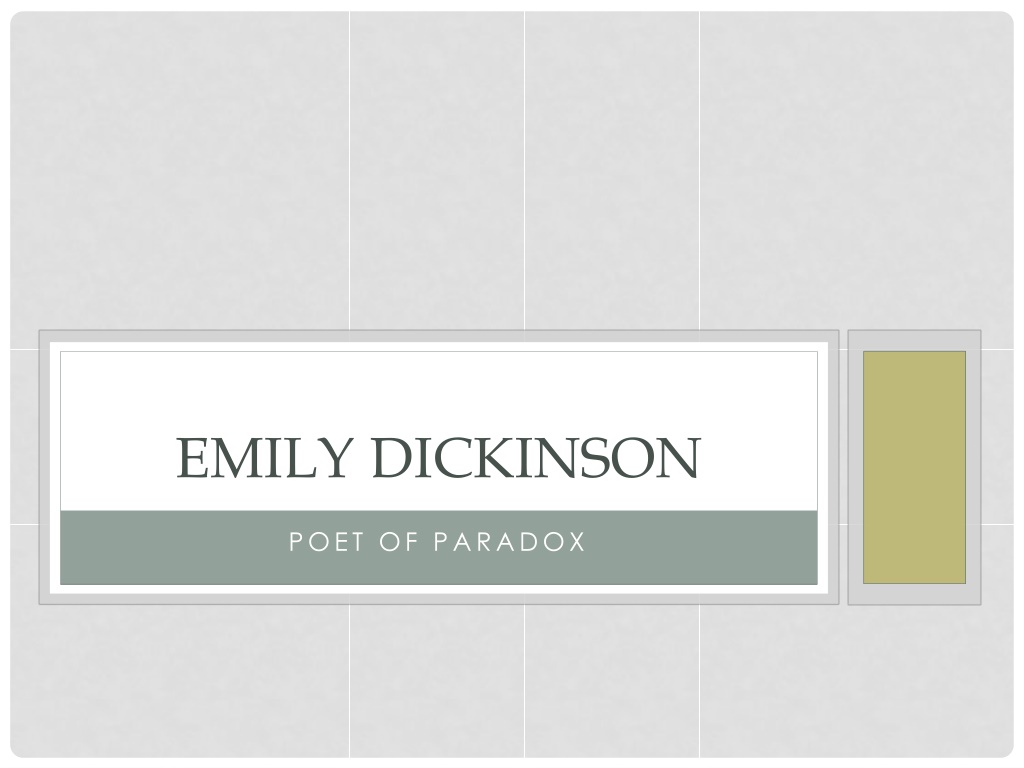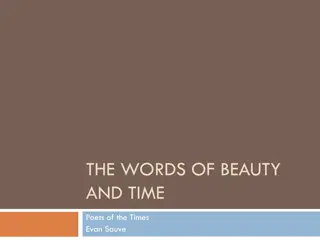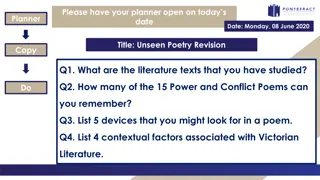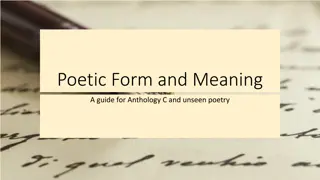Exploring Emily Dickinson's Poetry: Themes, Literary Devices, and Metrical Analysis
Dive into the world of Emily Dickinson's poetry with an exploration of her themes, use of literary devices, and a detailed analysis of metrical patterns in her work. Discover the paradoxes, personifications, and unconventional techniques that make her poems unique, while unraveling the interconnected themes of love and loss, faith and doubt, death and immortality, nature and humanity, and the power of imagination and God.
Download Presentation

Please find below an Image/Link to download the presentation.
The content on the website is provided AS IS for your information and personal use only. It may not be sold, licensed, or shared on other websites without obtaining consent from the author. Download presentation by click this link. If you encounter any issues during the download, it is possible that the publisher has removed the file from their server.
E N D
Presentation Transcript
EMILY DICKINSON POET OF PARADOX
LITERARY DEVICES Exact Rhyme: two or more words have identical sounds in their final stressed syllables One/Begun Slant rhyme: a close, but not exact rhyming sound, meant to disturb the reader s ear and draw emphasis One/Stone Eye/Majority Assonance: the repetition of similar vowel sounds in a line of poetry Hope is a thing with feathers ( i repeated) Paradox: a statement that seems to contradict itself but suggests some important truth; a contradiction that can be explained as true.
LITERARY DEVICES Consonance: repetition of constants in the middle or ends of words in a line of poetry Some late visitor entreating entrance at my door Personification: when an object, animal, or idea is given human characteristics Because I could not stop for Death, he kindly stopped for me Inversion: changing the natural order of words to fit rhyme scheme or meter Inebriate of Air am I Unconventional Punctuation dashes set off side thoughts and introduce interruptions of thought Unconventional Capitalization for emphasis
THEMES IN DICKINSONS POETRY Dickinson s poetry explores the relationship between Love and loss Faith and Doubt Death/immortality (does it even exist) and Life Nature and Humanity The power of God and The power of the individual imagination
BECAUSE I COULD NOT STOP FOR DEATH Scanning for meter U ` u Because I could not stop for death u ` u ` u ` He kindly stopped for me u ` u ` u ` u ` The carriage held but just ourselves u ` u ` u` And immortality ` u ` u ` The odd numbered lines are ____________________? The even numbered lines are ___________________? So the metrical pattern is alternating tetrameter and trimeter.
BECAUSE I COULD NOT STOP FOR DEATH Rhyme Scheme refers to the final syllable in a line. The first line is always labeled A Because I could not stop for Death A Now, look at the final rhyming sound of the second line does it rhyme with death? no label as B He kindly stopped for me Does the final rhyming sound of the third line rhyme with the first or the second? no label as C The carriage held but just ourselves Look at the final rhyming sound of the last line of the stanza does it rhyme with any of the other lines? Yes, with line 2 label as B And immortality Then, check the other stanzas to see if the pattern holds throughout the poem and if there is any slant rhyme ABCB is the pattern with slant rhyme on the 4thline of stanzas 2, 4, and 6
BECAUSE I COULD NOT STOP FOR DEATH How is Death personified in this poem? As a carriage driver, who kindly stops to pick up passengers Situational Irony? Death is characterized as a polite gentleman, as opposed to the Grim Reaper What three scenes does the carriage pass in stanza three? The school house at recess, the fields of grain, and the setting sun What aspects of life do these details represent? Stages of life (childhood, middle age, old age) In Stanza 5, what is the House that seemed/A Swelling of the Ground ? It is the speaker s newly dug grave graves always have a mound of dirt after they have been freshly filled Theme? The paradoxical nature of mortality and immortality death is inevitable, but in the afterlife (the speaker is recalling the day of her death centuries later) we continue to live on, but not necessarily in a heavenly paradise
I HEARD A FLY BUZZWHEN I DIED Subject: The moment of death Meter? Alternating tetrameter and trimester Rhyme Scheme ABCB* DEFE* GHIH* JKLK Speaker? NOT EMILY DICKINSON (just because she s the poet doesn t make her the speaker) Someone who is dying or just about to die
I HEARD A FLY BUZZWHEN I DIED Simile The stillness in the room/ was like the stillness in the Air/ between the heaves of storm The simile implies there is a tension in the room, like when you are waiting for thunder after you see the lightning Personification The Eyes around had wrung them dry And then the Windows failed Onomatopoeia stumbling buzz
I HEARD A FLY BUZZWHEN I DIED Who is in the room with the speaker at the time of her death, aside from the fly? Her loved ones The Eyes around had wrung them dry Who is the King that the speaker and the others in the room expect to witness at the time of death? God speaker and audience expect that God will be there to welcome the speaker s spirit into the afterlife What portion of the speaker is she not able to will away ? Her spirit/soul The fly interrupts the speaker at the moment of death, when she expects to see God what do the last two lines imply? That the fly, which represents the misery of human life, keeps the speaker from experiencing rapture
THERES A CERTAIN SLANT OF LIGHT Rhyme scheme? ABCB repeats the same pattern in each stanza No slant rhyme at all Meter? this one is hard because it s not iambic u u ` u ` u ` trimeter There s a certain slant of light ` u ` u ` trimeter Winter Afternoons u u ` u ` u ` trimeter That oppresses like the heft u u ` u ` dimeter Of cathedral tunes Is there a pattern??? in this case you have to check more than one stanza This poem is primarily trimeter, with the 4thline of the poem in dimeter.
THERES A CERTAIN SLANT OF LIGHT Subject? The light on winter days (think about how grey it is here on most winter afternoons) Simile in the first stanza? Compares the slant of light to the heft (weight) of church songs Both these things make the speaker feel weighted down, oppressed Personification Light Oppresses the speaker Landscape Listens to the light Shadows Hold their breath
THERES A CERTAIN SLANT OF LIGHT Alliteration certain slant of light heavenly hurt landscape listens Paradox Heavenly Hurt how could something that hurts us be heavenly? Setting A winter afternoon how do you feel on a winter afternoon? Depressed, sad, hurt The light is a metaphor for our own mortality winter reminds us we will die someday too
MY LIFE CLOSED TWICE BEFORE ITS CLOSE Rhyme Scheme? ABCB, ABCB No slant rhyme at all in this poem Meter? u ` u ` u ` u ` My life closed twice before its close u ` u ` u ` It yet remains to see u ` u ` u ` u ` If immortality unveil u ` u ` u ` A third event to me
MY LIFE CLOSED TWICE Subject The pain of losing something or someone that we love Paradox Parting is all we know of heaven/ And all we need of hell When we love someone, that s a chance to get to know what heaven might be like and when we have to leave that loved one, the pain that is caused is hellish Assonance Line 1: life and twice long i sound Line 2: remains to see long e sound Line 3: If Immortality unveil short i sound Alliteration Line 6: As these that twice befell th sound
THE SOUL SELECTS HER OWN SOCIETY Rhyme Scheme ABAB Stanza 1 ABAB* Stanza 2 Slant rhyme Gate/Mat ABAB* Stanza 3 Slant rhyme One/Stone Meter? Alternating tetrameter (odd # lines) and dimeter (even # lines) Subject? How people choose friends personifies the soul The soul selects its own society Our souls choose who to admit into our company and friendship
THE SOUL SELECTS HER OWN SOCIETY Paraphrase Stanza 1? Each person selects who they want to be friends with Then we close ourselves off From the rest of society We are absent Symbolism Emperors and Chariots Symbolize the rich and powerful who might want to befriend us or how they might want something from us Connection to Dickinson s own life? She spent 25 years of her life in her house She selected her own friends and then shut herself off from the rest of the world
THE SOUL SELECTS HER OWN SOCIETY Alliteration Line 1: The Soul selects her own Society Personification The soul choosing friends The soul noticing emperors and chariots and is unmoved The soul closes the valves of her attention Simile close the valves of her attention like stone Compares the valves of the soul s attention to a stone
THE BRAINIS WIDER THAN THE SKY Paradox The Brain is wider than the sky Contradiction the human brain is much smaller than the sky Truth the human brain contains more imaginative possibilities than the sky The Brain is deeper than the sea Contradiction the human brain is only a few inches deep, literally Truth the thoughts we can think are much deeper than the ocean The Brain is just the weight of God Contradiction what does God weigh? How can we measure God? Truth by using is just , the speaker is saying the brain is equal that of the weight of God the human soul, as described in the first two stanzas is infinite. This stanza confirms that the soul/brain is a creation of God
THE BRAINIS WIDER THAN THE SKY Meter Alternating lines of iambic tetrameter and trimester Simile The brain will absorb the sea as sponges absorb buckets of water Rhyme Scheme ABCB/DEFE/GHIH no slant rhyme The exact rhymes suit the meaning because the speaker is definite about these conclusions she has come to regarding the power of the human mind
THE BRAINIS WIDER THAN THE SKY Alliteration Line 12 S Assonance Line 3 and 7 o Line 4 e Line 5 e Line 11 I Consonance Line 1 n
THERE IS A SOLITUDE OF SPACE Types of solitude Space you can isolate yourself from people, making your space solitude Sea if you are out at sea, you are in solitude Death this speaker s version of death is solitary The speaker is saying that the best form of solitude is the inner solitude of aloneness Paradox/oxymoron Finite infinite how can there be an end to something endless?
WATER IS TAUGHT BY THIRST Imagery Line 1 gustatory Line 2 visual Line 3 tactile Line 4 auditory Line 5 visual Line 6 visual Theme To truly know and understand something, we must know its opposite, or what it is like to live without it























